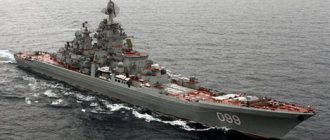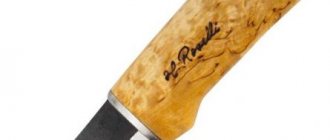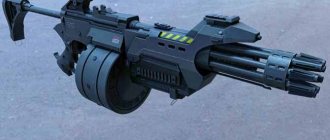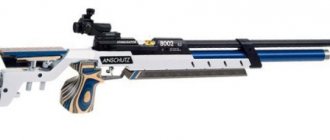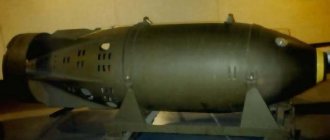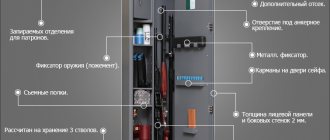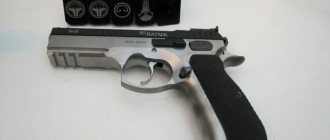“Destroyer URO” in dictionaries and encyclopedias | translation "destroyer uro"
Far left and second from right are Australian Darwin-class and Anzac-class guided missile frigates. To the right of Darwin are the Arleigh Burke-class destroyer Paul Hamilton, the Spruance-class destroyer Fletcher and (far right) the Type 42 guided missile destroyer Cardiff, December 16, 2002
Destroyer with guided missile weapons
(English
guided missile destroyer
, abbreviated URO destroyer; abbreviated English
DDG
) - a subclass of destroyers.
The main weapon of the URO destroyer subclass is not torpedo and artillery, but missile weapons, represented by anti-ship, anti-aircraft, tactical strike and anti-submarine guided cruise missiles. The standard displacement of modern destroyers reaches 7,500 tons (the displacement of the first representatives of destroyers at the beginning of the 20th century barely exceeded 200 tons), the total displacement is 10,000 tons or more. The record holder in terms of displacement may be the Zamvolt-class guided missile destroyers, whose total displacement should exceed 15,000 tons. Destroyers of this type are planned to be introduced into the US Navy by 2020 .
The characteristics of the displacement and main dimensions of modern guided missile destroyers are very similar to those of missile cruisers, so that at present the obvious difference between these two classes of ships has virtually disappeared
.
History of the origin of the class
Destroyers with guided missile weapons, as a special class of warships, appeared in the late 1950s. Construction of guided missile destroyers in the 1960s. For financial and technical reasons, only large countries such as the USA, USSR, Great Britain, France, Germany, etc. could
.
US Navy guided missile destroyer USS McCampbell (DDG-85)
| Destroyer USS McCampbell (DDG-85), Yokosuka | Destroyer USS McCampbell (DDG-85), Hong Kong | Destroyer USS McCampbell (DDG-85), Busan |
| Destroyer USS McCampbell (DDG-85), San Diego | Destroyer USS McCampbell (DDG-85) |
The guided-missile destroyer USS McCampbell (DDG-85) is the 35th in a series of 62 Arleigh Burke-class guided missile destroyers scheduled for completion on September 13, 2002, and approved by the U.S. Congress. Named after the most successful US Navy ace of World War II, David McCampbell.
The contract to build the ship was awarded to the Bath Iron Works shipbuilding company in Bath, Maine, and was the 20th ship built by the company. The keel laying ceremony took place on July 16, 1999. The christening and launching ceremony took place on July 2, 2000. The commissioning ceremony took place on August 17, 2002 in San Francisco, California. In July 2007, he arrived at his home port - the Yokosuka naval base (Japan).
Main characteristics: Normal displacement 6950 tons, full displacement 9648 tons. Length 155.29 meters, beam 20.4 meters, draft 9.4 meters. Maximum speed 32 knots. Cruising range 4890 miles at 20 knots. Crew 380 people, including 32 officers.
Engines: 4 General Electric LM2500-30 gas turbines with a total power of 108,000 hp. Mover 2.
Weapons:
Tactical strike weapons: 2 VPU for 32 (bow) and 64 (stern) missile cells: 96 x RIM-66 SM-2, BGM-109 Tomahawk or RUM-139 VL-Asroc.
Artillery: 1x1 127 mm. AU Mark 45. Mod. 4/62 cal., no more than 600 shells.
Anti-aircraft artillery: two 25 mm. ZAU "Bushmaster", four 12.7 mm. machine gun.
Mine and torpedo armament: 2x3 324 mm non-reloadable torpedo tubes Mk46 (6 torpedoes).
Missile weapons: one Phalanx CIWS shipborne anti-aircraft artillery system.
Aviation group: 2 SH-60 Sea Hawk helicopters, helicopter hangar.
Since July 2007, the ship has been part of the US Navy's Seventh Fleet, which is based in the Japanese port of Yokosuka.
In March 2011, she became the first US Navy ship to arrive to assist earthquake victims. On June 13, it went out to intercept a North Korean ship suspected of transporting ballistic missile components. After inspection of the cargo, the transport ship was forced to return to its home port in the DPRK.
On October 24, 2012, he rescued five Filipino sailors from a fishing boat.
On July 23, 2020, he arrived on a visit to Sydney (Australia), after completing his participation in the Talisman Saber 2017 exercise.
On December 5, 2020, the destroyer demonstratively passed near the base of the Russian Pacific Fleet in the Peter the Great Bay area.
Add to bookmarks:
Modern destroyers
American Arleigh Burke-class destroyer "Lassen"
Due to increased complexity and high cost, destroyers have ceased to be the most numerous class of ships. The size and displacement, as well as the purpose and capabilities of guided missile destroyers, vary widely depending on country and naval classifications
.
The general trends in the construction of destroyers of the main fleets at the beginning of the 21st century are: the use of combat information and control systems similar to the American AEGIS; introduction of “invisibility” elements into the design (stealth technology); increased automation; the associated increase in the share of auxiliary power plants; increased seaworthiness and habitability due to speed; qualitative increase in the capabilities of ships by reducing their number
.
Mutsuki-class destroyers
After the Russo-Japanese War, two types of destroyers took shape in the Japanese Imperial Navy: 2nd class ships were designed to operate in coastal waters, and 1st class ships in the ocean.
The evolution of 1st class destroyers began in 1907, when two Umikaze-class ships with a total displacement of 1,500 tons were ordered from domestic shipyards. They were distinguished by a very advanced design, having received oil-heated boilers and 120-mm main caliber guns. Two 1st class destroyers of the Urakaze type were ordered by the British in 1912. All subsequent ships were built at Japanese shipyards. The peak of their development occurred in the second half of the First World War and the first post-war years.
PREDECESSORS
In 1917, the fleet was replenished with four Amatsukaze-class ships. Outwardly, they resembled enlarged 2nd class destroyers of the Kaba type, but had steam turbines instead of steam engines, powerful artillery weapons (four 120 mm cannons) and reinforced torpedo weapons (six 457 mm torpedo tubes). An improved version of this project was the Tanikaze-class destroyers (two units). The next 1st class destroyers of the Minekaze type were built after the First World War (15 ships entered service in 1920-1922). They opened a new stage in Japanese shipbuilding, which was marked by a transition from direct copying of foreign designs or imitation of the latter to their own projects. However, according to naval historians, the Minekaze project shows the influence of the German school of shipbuilding - the placement of one of the torpedo tubes in the bow. The ships were armed with four 120-mm guns and three twin-tube 533-mm torpedo tubes, and a powerful power plant allowed them to reach a speed of 39-40 knots. The nine ships of the Kamikaze type, which entered service in 1922-1925, basically repeated the previous project. They became the predecessors of the Mutsuki-class destroyers.
DESIGN FEATURES
The hull design of the Mutsuki was similar to that of the Kamikaze. Her most characteristic feature was the short forecastle, between the section of which and the superstructure there was a bow torpedo tube.
The length along the waterline has increased somewhat - thanks to the appearance of a double-kinked stem, which for many years became a kind of “calling card” of Japanese ships.
The two-shaft main power plant, consisting of steam turbines of the Parsons system (manufactured under license in Japan) and four Kampon "Ro-Go" ("small type") boilers with oil, remained unchanged compared to the previous type on most ships of the series. heating. With a power of 38,500 hp. With. it provided the ship with a speed of over 27 knots. Experimental French-made steam turbines were installed on two destroyers: “Rato” on the Yayoi and “Zolly” on the Nagatsuki.
Read: “Raumbots” - minesweeper boats of the Kriegsmarine
WEAPONS
The ships' artillery armament corresponded to Kamikaze-class destroyers and consisted of four 120-mm Type 3 guns with a barrel length of 45 calibers. Such a weapon weighed 3,420 kg and had a maximum firing range of 16,000 m. The practical rate of fire with a trained crew was five to six rounds per minute. The high-explosive fragmentation projectile weighed 20.3 kg.
At first, anti-aircraft weapons were purely symbolic - only two 7.7 mm machine guns. During the Second World War, it was significantly strengthened due to the installation of 25-mm Type 5 automatic cannons (10-20 units) and 13.2-mm Type 93 machine guns (up to five), but at the same time two of the four guns were removed main caliber. Both models were produced in Japan according to the type of French cannons and Hotchkiss machine guns. In terms of their characteristics, they were noticeably inferior to the small-caliber anti-aircraft guns of the opponents of the Japanese fleet, and above all the US Navy. A significant step forward compared to its predecessors was the Mutsuki's torpedo armament. The ships became the first in the Japanese fleet to receive 610 mm torpedoes - first Type 8 and later Type 93. The latest model carried a 300-kg warhead and could travel 18 km at a speed of 27 knots or 10 km at a speed of 37 knots. Another innovation was the use of three-tube torpedo tubes instead of the usual two-tube ones. This made it possible to reduce their number while maintaining the number of torpedoes in a broadside salvo. At the same time, the free deck space has increased.
To combat enemy submarines, Mutsuki carried 18 depth charges. The possibility of receiving on board 16 minutes was provided. But the ship could not only lay mines, but also fight them. In accordance with the prevailing views in the leadership of the Imperial Japanese Navy at that time, destroyers, if necessary, were supposed to serve as high-speed minesweepers. Therefore, ships of the Mutsuki type received sets of minesweepers.
Read: Aegis combat system
CONSTRUCTION AND SERVICE
The Imperial Japanese Navy ordered 12 Mutsuki-class destroyers under the 1923 program. The planned construction of nine more ships of this type was subsequently abandoned.
Initially, the destroyers did not have names, but only numbered names: 19, 21, 23, 25, 27-34. In the Imperial Navy at that time, odd numbers were assigned to first-class destroyers, and even numbers were assigned to second-class destroyers.
But, starting with number 27, this division was abandoned, and the numbering was now consecutive. In 1928, the ships were given names derived from the word “month”. In Japanese, as in Russian, it has two meanings - calendar and the name of a celestial body. For example, the name of the destroyer "Minazuki" is translated as "waterless month" (June), and "Mochizuki" is translated as "full moon". Orders for Mutsuki-class destroyers were distributed among five shipyards - three private and two public. The lead ship and the Mikazuki built an arsenal in Sasebo, the Kisaragi and Kikuzuki built an arsenal in Maizuru. The Uraga shipyard in Tokyo received a contract for Yayoi, Minazuki and Mochizuki, (also in Tokyo) for Uzuki and Nagatsuki, and Fujinagata in Osaka for Satsuki, Fumizuki " and "Yuzuki". All of them were built during 1925-1927.
SERVICE
After entering service, the Mutsuki-class destroyers formed three divisions of four ships, distributed between the 5th and 6th destroyer flotillas. In December 1931, the 30th Division (Mutsuki, Kisaragi, Yayoi and Uzuki) was transferred to the 1st Flotilla. This division took part in the First Shanghai Battle in January - March 1932, providing fire support to Japanese ground units. Subsequently, Mutsuki-class destroyers took an active part in the war with China. Their main task was to ensure a blockade of the Chinese coast.
By the time Japan entered World War II, all ships of this type had left Chinese waters and joined the United Fleet. The 30th Division, 6th Destroyer Flotilla, participated in the capture of Wake in December 1941. The 23rd Division was also involved in it (Kikudzuki, Yuzuki and Uzuki; the last ship in the 30th Division was replaced by Mochizuki). On December 11, Kisaragi was attacked by fighters from the VMF-211 squadron based on the island. The machine gun fire detonated the depth charges, and the ship quickly sank to the bottom, becoming the second Japanese destroyer to die.
Read: Tanks of the Japanese Self-Defense Forces
The 22nd Division (Satsuki, Minazuki, Fumizuki and Nagatsuki) took part in the occupation of Malaya from December 1941 to January 1942. Since February, all divisions have served in the waters of the Dutch East Indies. In May, Uzuki, Mutsuki, Mochizuki and Yaei fought off New Guinea, and Kikuzuki and Yuzuki fought off Tulagi Atoll. Here they were attacked by dive-bombers from the aircraft carrier Yorktown, as a result of which the Kikuzuki sank. In 1941-1942, half of the Mutsuki-class ships were converted into high-speed transports. Their artillery armament now consisted of two 120 mm guns and ten 25 mm machine guns, and torpedo tubes, equipment for laying mines and mine sweeping were completely dismantled. But they additionally installed four bomb launchers with 36 depth charges. The ships' displacement increased to 1913 tons, and the maximum speed dropped to 34 knots.
TACTICAL TECHNICAL CHARACTERISTICS (AT THE TIME OF ENTRY INTO SERVICE) OF THE DESTROYER "MUTSUKI"
- Total displacement, t: 1468
- Dimensions, m: - length: 102.72 - width: 9.16 - draft: 2.96
- Technical characteristics: - speed, knots: 37.3 - range, miles: 3600 (at 14 knots)
- Power plant: two steam turbines with a total capacity of 38,500 hp. s, four steam boilers
- Crew, people: 154
- Armament: - artillery: 4 120 mm guns, 2 7.7 mm machine guns - torpedo: 2 610 mm three-tube TA - anti-submarine: 18 depth charges - mine: 16 mines - minesweeper: set of contact trawls
You might be interested:
- Destroyers of types "O" - "Z"
- V/W type destroyers
- Benson-class destroyers are the workhorses of the fleet
- Ships of the Giering type are the pinnacle of development of American destroyers
- British destroyer Kelly
- "Soldati" - the best Italian destroyers of World War II
Subscribe to
our channel in Yandex.Zen
Five Argentine aircraft took off from the Rio Grande airbase and headed for the Falklands. Two deck-based attack aircraft of the French production “Super Etandar” under the right console carried one Exocet anti-ship missile, and under the left one there was a drop-down fuel tank with a capacity of 1100 liters. One aircraft with the same weapons was a reserve, and the other two carried only fuel tanks, performing the functions of tankers.
Already in the air, the pilots received information that two large English ships, presumably destroyers, had been discovered south of the Falkland Islands. This important message was received from the Neptune reconnaissance aircraft, which flew into the area 30 minutes earlier. British long-range radar patrol ships were discovered - the destroyer URO Sheffield and the frigate URO Plymouth.
Apparently, the British did not expect the appearance of Argentine aviation. The weather in the area was unflyable: the horizontal visibility range was no more than 400 m, and the lower edge of the clouds descended to 100 m. At this time, Sheffield was negotiating with London via the Skynet satellite communication channel. To eliminate interference, the ship's commander ordered to turn off all on-board electronic equipment. Only one search radar operated on Plymouth.
Having turned off the on-board radars, the Argentine pilots descended to an extremely low altitude and increased their speed, and then sharply changed course in the hope of approaching the enemy from a southern direction. The British considered the eastern and western directions the most threatened.
At a distance of 50 km from the British ships, the pilots, having jumped to 150 m, turned on the radar for a few seconds. Both targets appeared on the indicators. Without wasting a second, the pilots entered target designation data into the on-board cruise missile computers and fired an Exocet missile at each target. At the time of launch, the onboard equipment registered the operation of the Plymouth radar. After the launch of the “Super Etandar” missiles, having dropped to a height of 30 m, they turned around and went towards the mainland.
The first missile on the frigate Plymouth was detected using radar almost a minute before approach. The ship managed to set up passive interference in the form of a cloud of dipole reflectors, which the missile was aimed at.
The active radar head, homing of the second missile, captured “Sheffield” at a distance of 12-15 km, on the final part of the trajectories the missile’s flight altitude decreased from 15 to 3 m. The missile was noticed from the ship only 6 seconds before the hit and the commander only managed to command: “Take cover” !■ . .
The missile penetrated the 10-mm plating of the destroyer's side under the superstructure of the main command post at altitude. 1.8 m above the waterline, flew through the galley and entered the engine room. The explosion of the remaining rocket fuel caused a fire in the fuel tanks, which soon engulfed the entire middle part of the ship's hull. Its spread was facilitated by a drop in steam pressure and the failure of electricity generators that powered fire pumps, as well as the fire of interior decoration made of synthetic materials, ship superstructures made of light aluminum-magnesium alloys and electrical cable sheaths that burned like gunpowder. The premises very quickly filled with thick toxic smoke, and soon there was a threat of explosion of rocket and artillery ammunition.
After a four-hour fruitless struggle for survivability, having lost 20 people killed and 28 people wounded, the Sheffield commander, Captain 2nd Rank Salt, gave the order: “Abandon ship!” The fire was extinguished by ships that came to the rescue.
The agony of “Sheffield” lasted almost a week. An attempt to tow the ship to South Georgia Island ended in failure. Having lost its reserve of buoyancy, the Sheffield sank on May 10 at a depth of 300 m.
Corner of the sky. 2004 (Page: Modification date: )
